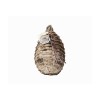The prince of salami
Salame di Felino PGI (Protected Geographical Indication), also called Felino salami, takes its name from the municipality of the same name in the province of Parma which has a centuries-old tradition in the processing of this type of salami.
Its territory, thanks to the particular microclimate that characterizes it, in addition to the proximity to Salsomaggiore and Salsominore from which, once upon a time, the producers obtained the salt used in the salami dough, is one of the secret elements that have made it so good and tasty this salami.
THE HISTORY OF SALAME FELINO
Since the Bronze Age, the Felino area has had a strong link with the pig.
As proof of this there are the numerous pig bone fragments found among the finds of the terramaricolo village of Monte Leoni, which is located on the hills overlooking the town.
The first bibliographical references relating to the salami of Felino date back to the 1st century AD.
Several Latin authors speak of it, including Marco Gavio Apicius in his De re coquinaria.
While its first representation dates back to the thirteenth century and is visible in the Baptistery of Parma, designed by Benedetto Antelami (sculptor and architect, editor's note).
Where there is a tile, set in the slab dedicated to the zodiac sign of Aquarius, in which a man is represented intent on working in the kitchen and on the support to which the pot is attached there are two salamis hung to dry that have the same shape and size of the current Felino salami PGI.
You must know that until 1500 our ancestors used to cook any type of cured meats (including salami and ham, editor's note), before consuming it.
From this date onwards we begin to consume raw salami and we know this because the first raw salamis begin to appear in still life paintings.
At this point, you may be wondering why salami was depicted in this type of painting.
The answer to this legitimate question is… because this salami was very precious and prestigious, so much so that the Jesuits of Parma, every year at Christmas, used to give the Pope a basket of Felino salami.
Just think that at the time it was more expensive than ham and culatello from Zibello.
This is essentially for two reasons:
1) it was difficult to make as being made with minced meat it had a greater risk of bad results. It could happen that there was air or bad fermentation that would spoil the product;
2) It also contained pepper, a spice that came directly from India after a long voyage of more than six months that first reached the ports of the Red Sea from the Indian coasts by ship. From here on camel back he reached the shores of the Mediterranean Sea. From where, finally, he resumed the sea route until reaching Venice, a city that for a long time, in Europe, had the almost exclusive monopoly in the spice trade.
But let's go back to the story of the prince of salami.
In the past, the pork used for its production was that of the black pig that lived in the wild in the territories of Parmesan, eating acorns which give a particular flavor to its meat.
However, this breed of pigs takes two years to reach the right maturity for slaughter.
For this reason, in 1880 the Bourbons who ruled Parma and its province at the time began to import the Large White pig from England, which matures in one year and has a larger tonnage.
Initially, this species was hybridized with the black pig.
But over time it supplanted the latter precisely due to the fact that it grew faster.
Before the advent of industrial cured meat factories, during the twentieth century, the pig, after it had been fattened, was killed by the Norcino (butcher), in winter, on a particularly cold and dry day, also called the day of the kill, the ancient cruel feast.
Cruel but essential for the survival of the farmer's family.
Short note: the term norcino (pigs butcher), derives from Norcia, a village in Umbria where there was an important medical school.
You must know that until 1482 when Pope Sixtus IV authorized the dissection of corpses it was believed that this practice had been prohibited by the Church and led as a consequence to the direct excommunication of those who practiced it.
So doctors, to learn how bodies were made, practiced on pigs, which internally are the living beings most similar to humans.
And the butchers were, in fact, the employees of the Norcia medical school who had the task of opening the pigs to show how they were made inside.
Hence the term norcino was translated to all those who dissected the pigs regardless of whether they did it in the city of Norcia or not.
I have another curiosity for you. Around 1897 in Milan, the salami that was initially called in a generic way "of Parma" will be rebranded "of Felino" to underline the quality of the product made with the meat of mountain pigs that ate acorns.
Side note: in 1990 the black pig, which currently lives in the wild in the upper Parmesan Apennines, was recovered giving rise to niche salami production.
HOW FELINO SALAMI IS MADE
To produce Salame Felino PGI, mainly selected pure Italian pork meats or derivatives of the traditional Large White and Landrace basic breeds are used, which must have an average slaughter weight of 160 kg.
These meats are then ground with pepper, salt and pounded garlic.
To them can be added:
- sugars
- dry white wine
- potassium and / or sodium nitrate
- sodium and / or potassium nitrite
- ascorbic acid and its sodium salt
- starter cultures for fermentation
This makes the Felino salami taste sweet and delicate, and has a ruby red color. A spot-free meat, tastier than that of other salamis on the market.
The mixture is stuffed into natural pork intestine which is tied by hand with a string.
The drying lasts a minimum of 4 days and a maximum of 6 and is carried out hot at a temperature between 13 ° and 24 ° C.
After this phase, curing takes place in rooms other than those used for drying and lasts at least 25 days.
At the end of all this process we have a Felino salami PGI whose weight is between 200 g and 4.5 kg, while the length varies between 15 cm and 130 cm.
CONCLUSION
I hope you enjoyed the journey to discover the prince of salami of the culinary tradition of Emilia Romagna, which has become an Italian food excellence.
Don't miss the next articles: subscribe to my Newsletter and visit the blog!
See you in the next post!
Ciao and bye bye,
Mamma Rosa



